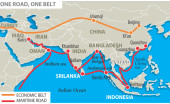Re Ian Bremmer 'Could third-party candidates upend the 2024 US election?' 3 April The current political movement in the USA…
Cutting China's carbon cost
Written by Diana Thebaud Nicholson // June 30, 2007 // China, Environment & Energy, Science & Technology // 1 Comment
29 June 2007
Source: SciDev.Net
A report by the Netherlands Environmental Assessment Agency (19 June) claims that China is now the world’s biggest emitter of carbon dioxide, and the vast amount of cement China is producing to fuel its building spree is a prime culprit.
Projects like Tianjin Cement Industry Design & Research Institute’s successful development of new technology to generate energy from the waste gases emitted during cement making provide evidence that the country is adopting measures to put the brakes on pollution, while still maintaining its momentum in manufacture.
A revolving kiln humming inside the Zhejiang Shenhe Cement company makes cement from its raw materials, is part of a United Nations project with China to encourage businesses to reduce carbon emissions by adopting energy-efficient technologies. The system uses the heat from waste gases produced in the kiln during the cement-making process both to dry the cement and to heat water in a boiler that drives a turbine to produce electricity. Almost nothing is wasted.
Since it has been in operation, the new facility has generated an accumulative power of 25 million kilowatt hours, supplying one third of the required power for the company, helping the factory to cut carbon dioxide emissions by 20,000 tons annually by reducing the need to burn coal for power.Today, the Tianjin institute has helped 30 domestic cement production lines build similar facilities for low-temperature waste-heat recovery.
Energy efficiency is not the norm
Despite the success of Tianjin institute and Shenhe Cement, achieving energy efficiency is still unusual in this industry. China’s cement industry consumes 44 per cent more energy per unit than in developed countries, and the rapid development of energy-intensive industries, such as steel, copper and electricity, offset individual efforts.
According to the Netherlands Environmental Assessment Agency, both the soaring demand for coal to generate electricity and the surge in cement production have pushed China’s recorded carbon dioxide emissions for 2006 beyond those of the United States by eight per cent.
“Despite the apparent benefits of saving energy, our projects cannot get enough financial support from banks, who worry that the loan cannot be returned on time,” says Jin Jiaman, director of the Beijing-based Global Environment Institute, which has promoted energy-efficiency technologies in China’s cement industry.
Energy-efficiency projects, such as those based on solar and wind power, are also hindered by China’s lack of technology. Despite its cheap labour, China’s solar battery costs are 30 per cent higher than its German and US counterparts.
Sharing climate-friendly know-how
Lu Xuedu, deputy director general of the Office of Global Environmental Affairs in the Ministry of Science and Technology, said that developed countries’ willingness to transfer low-carbon technologies is the key to helping developing countries to lower their emissions.
One example is technology for generating wind power, he said. At present, China is only able to build small-scale wind farms with a production capacity of 800 kilowatts. But with the technology used in some developed countries, wind farms with a capacity as large as 30,000 kilowatts could be set up.
Another technology that developing countries are seeking urgently but cannot develop on their own because of the high cost is carbon capture and storage, where carbon is captured from power plants and stored, for example underground.
If developed countries cooperate with China under the Clean Development Mechanism (an arrangement specified in the Kyoto Protocol that allows industrialised countries to offset their emissions by investing in emission reducing projects in developing countries) this might be possible.
Transferring technology, creating rivals
There are three types of technology that developed countries are reluctant to transfer, says Gong Zhongming, a researcher at the National Research Centre for Science and Technology for Development. “The first are those with a potential for military application, such as satellite observation technologies; the second are those that give a strong industrial competitive edge; and the last are those related to resources and energy control. These two are crucial for economic development, which developed countries do not want to see in less developed ones,” Gong said.
Article




One Comment on "Cutting China's carbon cost"
I worked with a couple of cement plants in China.
The one in Dalian spewed forth so much pollution that one could not see the other side of the valley. When querried
about this, the owner said that he had bought all of the required equipment to clean up the plant but that he would not install it until the government forced him to.
This reinforces one of the paragraphs in the article referring to the reluctance to add additional costs to the manufacturing process for pollution concerns.
What I have seen just about everywhere is good laws that are not enforced.The ongoing benefits of additional operating costs will have to be proven to make it work or the penalties will have to have a major deterrent effect. Robert Travers